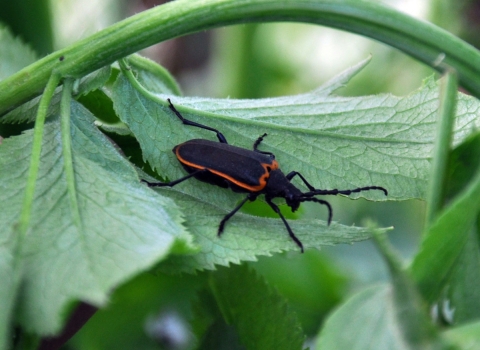On her first visit to the Midwest Region, Director Williams stopped by Detroit River International Wildlife Refuge, the only international wildlife refuge in North America. Located along the lower Detroit River and western shoreline of Lake Erie - just 20 miles south of Detroit, Mich., and 50 miles north of Toledo, Ohio, the refuge provided a backdrop for Director Williams to learn about the latest from the Service’s Fish and Aquatic Conservation program’s work with many partners to conserve lake sturgeon. Her visit also highlighted the results of Great American Outdoors Act funding to increase access to public lands and waters in the greater Detroit metropolitan area.
“Michigan represents the ideal intersection of two of our conservation priorities: preventing extinction and managing national wildlife refuge national wildlife refuge
A national wildlife refuge is typically a contiguous area of land and water managed by the U.S. Fish and Wildlife Service for the conservation and, where appropriate, restoration of fish, wildlife and plant resources and their habitats for the benefit of present and future generations of Americans.
Learn more about national wildlife refuge lands for people and wildlife,” said Director Williams. “From Seney’s remote forests to Detroit River’s recovered waterway, Michigan’s national wildlife refuges showcase diverse habitats and abundant recreation opportunities.”
Director Williams also pointed to the strong partnerships that led to the recovery of the Kirtland’s warbler, the growing populations of endangered Great Lakes piping plovers, and work to save critically imperiled species like the Poweshiek skipperling.
“I couldn’t think of a better place to talk about the importance of the Endangered Species Act than out on a boat on the Detroit River. Thanks to the habitat restoration, contaminants work and the vision of a whole host of conservation professionals, it’s once again a common sight to see bald eagles and other species that were once on the brink of extinction,” Director Williams said. “Getting out in the field to see the excellent work we’re doing to protect lake sturgeon makes me proud. I’d like to give a big thanks to our partners as we use every tool in our conservation toolkit.”
In 2001, Detroit River International Wildlife Refuge was established by Congress as a result of efforts by U.S. and Canadian politicians, conservation leaders and local communities to build a sustainable future for the Detroit River and western Lake Erie ecosystems. In recognition of this collaboration and with the understanding that wildlife does not acknowledge geographic boundaries, the refuge was given international status, making it the first and only of its kind in North America.
Nearly $3.9 million in funding from President Biden’s Bipartisan Infrastructure Law Bipartisan Infrastructure Law
The Bipartisan Infrastructure Law (BIL) is a once-in-a-generation investment in the nation’s infrastructure and economic competitiveness. We were directly appropriated $455 million over five years in BIL funds for programs related to the President’s America the Beautiful initiative.
Learn more about Bipartisan Infrastructure Law has been used to fund four fish passage fish passage
Fish passage is the ability of fish or other aquatic species to move freely throughout their life to find food, reproduce, and complete their natural migration cycles. Millions of barriers to fish passage across the country are fragmenting habitat and leading to species declines. The U.S. Fish and Wildlife Service's National Fish Passage Program is working to reconnect watersheds to benefit both wildlife and people.
Learn more about fish passage projects in Michigan, two of those specifically to benefit lake sturgeon.
Director Williams also met with staff at Shiawassee National Wildlife Refuge near Saginaw, Mich. This 10,000-acre refuge is situated at the convergence of four major rivers in central Michigan. The rivers support wildlife, power the economy, and offer opportunities for recreation. Over the past decade, recreational use of the rivers and the refuge has risen dramatically, and habitat restorations have reconnected floodplains that were cut off from the rivers for more than 100 years, expanding habitat for native fish.
The National Wildlife Refuge System is the world’s largest network of conservation lands and waters dedicated to the conservation of native wildlife and their habitats encompassing 570 national wildlife refuges and 38 wetlands management districts covering more than 95 million land acres and 740 million acres of submerged lands and waters.
Today’s announcement comes as the Department celebrates the 50th anniversary of the ESA. The ESA has been highly effective and credited with saving 99% of listed species from extinction. Thus far, more than 100 species of plants and animals have been delisted based on recovery or reclassified from endangered to threatened based on improved conservation status, and hundreds more species are stable or improving thanks to the collaborative actions of Tribes, federal agencies, state and local governments, conservation organizations and private citizens.
Learn more about the National Wildlife Refuge System.
Learn more about the 50th anniversary of the Endangered Species Act.



